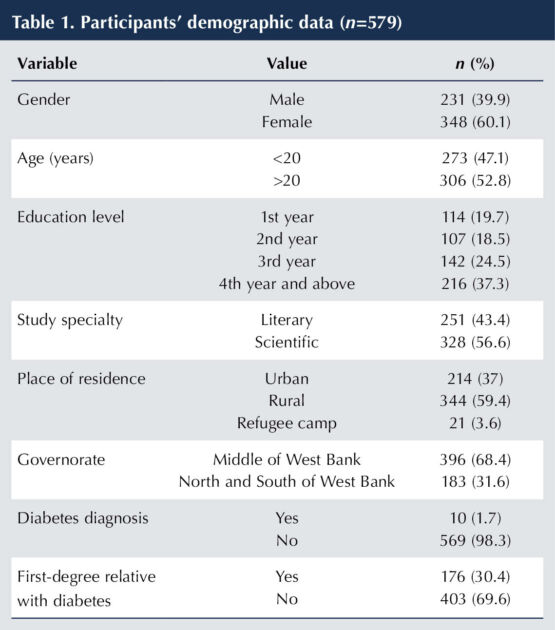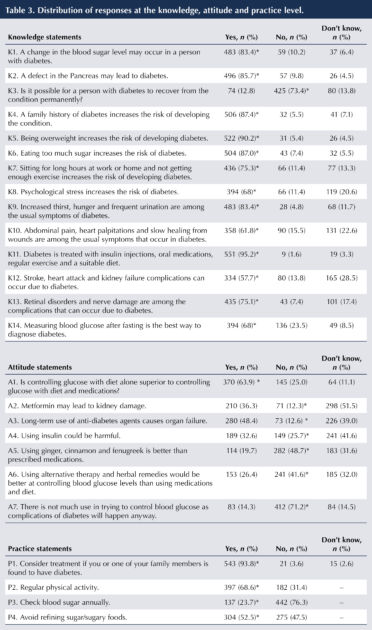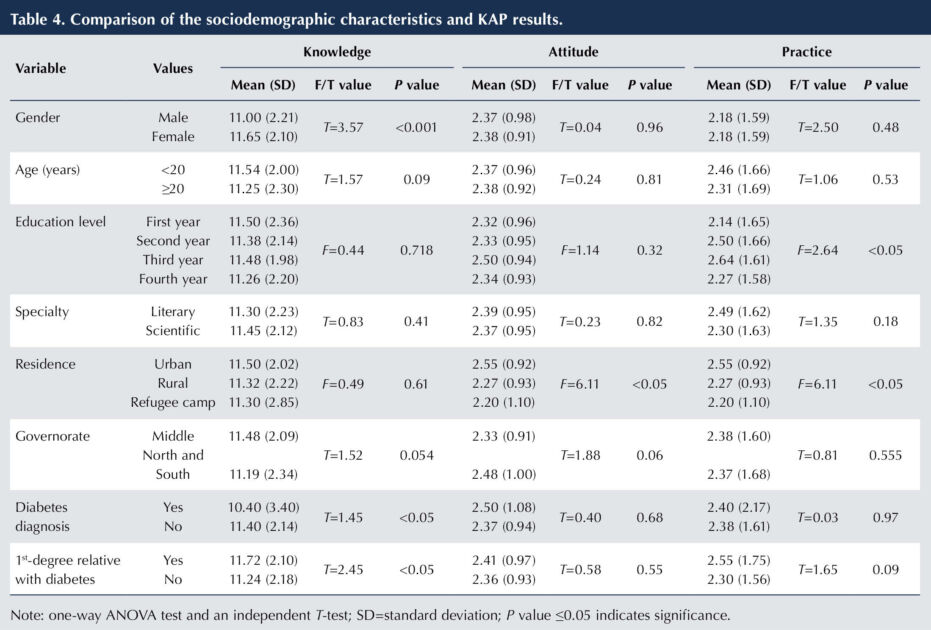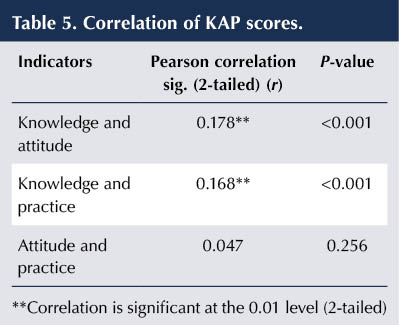As the prevalence of diabetes increases globally, the health and well-being of individuals, families and communities are being threatened. In 2021, the International Diabetes Federation announced that 537 million adults had from diabetes, and it expects this number to rise to 643 million by 2030 and 783 million by 2045 (International Diabetes Federation, 2021). An increasing dependence on unhealthy lifestyle behaviours, such as fast foods and drinks, and resulting obesity is contributing to this.
In Palestine, diabetes is the fourth leading cause of mortality. Compared to a global prevalence of 6%, the prevalence of diabetes in the population of Palestine has increased to around 15.3% (World Diabetes Foundation, 2023). Early detection of the condition and effective management can prevent diabetes complications, while regular exercise, diet and weight management are ways to achieve optimal glycaemia (ADA Professional Practice Committee, 2022).
Studies have examined diabetes knowledge, attitudes and practices (KAP) among populations, and the relationships between KAP and people’s demographic information (Aljofan et al, 2019; Alsous et al, 2019; Alqahtani et al, 2020). Some have indicated that knowledge among university students is good (Alsous et al, 2019; Akter et al, 2022), while others have shown the opposite (Khlaifat et al, 2020; Diallo et al, 2021; Sitaula et al, 2022; Al-Mutawaa et al, 2023). Results have also varied regarding diabetes knowledge between males and females, with some indicating that males have more knowledge (Alqahtani et al, 2020), others that females do (Gazzaz, 2020), and still more showing no difference (Mohammed et al, 2018).
Having first-degree relatives with the condition and an education in a medical field are shown to be associated with higher diabetes knowledge scores (Alsous et al, 2019). These group also demonstrated appropriate practices towards diabetes, including preventative lifestyle measures and blood glucose monitoring (Alqahtani et al, 2020; Mekonnen et al, 2020; Quisao et al, 2021). A Saudi Arabian study found that a high percentage of participants would seek treatment if they or a family member developed diabetes, and 49.9% exercised regularly. More than half of the respondents did not undergo an annual blood glucose test, and 55.9% avoided refined sugar (Alqahtani et al, 2020). Studies have shown variable attitudes toward diabetes (Herath et al, 2017; Alsous et al, 2019; Al-Mutawaa et al, 2023), with those with higher socioeconomic status displaying much more positive attitudes than those with low socioeconomic status (Gillani et al, 2018; Abdulrahman et al, 2020).
The current study aimed to determine the level of diabetes knowledge, attitude and practice among the students at Birzeit University, and establish associations with other potential factors. There has been a lack of previous studies conducted in Palestine.
Methodology
Study design and setting
This study employed a descriptive cross-sectional design to examine the relationship between participants’ demographic characteristics and the level of KAP towards diabetes among students at Birzeit University, a sizeable Palestinian university with students from all over the West Bank of the occupied Palestinian territory.
Study participants and sampling
The study population included undergraduate bachelor’s degree students from different specialties at Birzeit University. Master’s, doctoral, irregular, detainee, dismissed, graduated and withdrawn students were excluded. The targeted population of students was 13270, and the sample size needed to power the study was calculated as 385, with a 95% confidence level and a 5% error margin (The Survey System, 2024). We collected 579 cases to account for the design effect.
Structure of the questionnaire
A previously published diabetes-validated questionnaire about KAP towards diabetes was obtained (Herath et al, 2017; Alsous, 2019; Gazzaz et al, 2020). The Arabic translation was used in this study, with a few minor adjustments to make it appropriate for studying the Palestinian community. A pilot study with 18 participants was then conducted to evaluate the questionnaire’s clarity.
As a result, the final survey was divided into four sections. The first was about sociodemographic data, including age, gender, college, academic level, place of residence, diagnosis of diabetes, having a first-degree relative with diabetes, and how information about diabetes was sourced.
The second component, which assessed understanding of diabetes, consisted of 14 questions. Respondents could answer “Yes”, “No” or “Don’t know”. Each accurate response received one point, and the overall score was computed out of a possible 14. Score ranges of 0–8 and 9–14 were classified as having poor and good knowledge, respectively.
The third component assessed attitudes towards diabetes. It consisted of seven questions that could be answered “Yes”, “No” or “Don’t know”. The total score was determined out of 7, with one point awarded for each correct response. Score ranges of 0–3 and 4–7 were classified as negative attitude and positive attitude, respectively.
The fourth part, testing the student’s practice towards diabetes, consisted of four questions, again offering the categorical replies “Yes”, “No” and “Don’t know”. Each accurate response was worth one point, with a possible high score of 4. Scores of 0–2 were classified as inappropriate practices, and 3–4 as appropriate practices.
The overall reliability of the questionnaire, as measured by calculating the Cronbach’s alpha coefficient, was 0.616.
Data collection and ethical considerations
Birzeit University’s Institutional Review Board committee gave permission for the study. The questionnaires were distributed electronically via WhatsApp and Facebook, and face-to-face between April and May 2023. A page outlining the nature of the study, its objectives, and a consent declaration were included in the questionnaire. Completion of the questionnaire constituted consent to participate, and participants were free to peruse this page at their leisure. Additionally, participants could leave the research at any moment, if they were unable or unwilling to finish the questionnaire for any reason.
There were 190 paper questionnaires distributed, while 400 questionnaires were filled out electronically. Excluding surveys that were not fully or accurately answered, 179 questionnaires were approved after distribution, giving a total of 579.
Data analysis
Descriptive statistics (frequency, percentages, means and standard deviations) were used to analyse all of the questions once they were coded and imported into SPSS version 25. The associations between research variables were investigated using one-way ANOVA and independent sample t-tests with statistical significance.
Results
Participants’ characteristics
A total of 579 students participated in the study, of whom 39.9% were male and 60.1% were female (Table 1). Ages ranged from 18 to 28 years. About 29.9% of the participants had first-degree relatives with diabetes, and 56.6% were studying scientific specialties.
Students obtained information regarding diabetes from a number of sources, most commonly reported as being through social media platforms (58.2%) and healthcare professionals (54.1%).

Diabetes knowledge
The knowledge (K) questionnaire had 14 questions: three on basic knowledge (K1–K3); five on causes and risk factors (K4–K8); two on signs and symptoms (K9–K10); one on management (K11); two on the complications of diabetes (K12–K13); and one on diagnosis (K14) (Table 3).
Based on the scoring classification outlined above, 127 (22%) of the students had a poor knowledge level and 452 (78%) had a good level (Table 2). Knowledge was generally good, with a mean score of 11.38 (SD, 2.16). One of the more difficult questions, about whether the pancreas is affected in this condition, was answered correctly by the large majority.

Attitudes towards diabetes
Attitudes towards diabetes were measured by seven questions (A1–A7; Table 3). Based on the classification of scores outlined above, 228 (39.4%) of the students showed positive attitudes, while 351 (60.6%) showed negative attitudes. The mean score for participants was 2.38 (0.94). Most of the students preferred to regulate glucose levels in type 2 diabetes through diet alone, while some preferred to regulate it through diet and medication together.
Practice toward diabetes
Practices towards diabetes were measured by four questions (P1–P4; Table 3). Based on the classification of scores outlined above, 345 (59.6%) of the students showed appropriate practices and 234 (40.4%) showed inappropriate practices. The mean score for participants was 2.38 (1.62). The great majority of participants (93.8%) said they would seek treatment if they, or a family member, had diabetes, and 68.6% exercised often. However, more than half of the study participants did not regularly monitor their blood glucose levels. Refined sugar was used by more than half (52.5%) of individuals.

Sociodemographic information and KAP
Table 4 compares the socioeconomic characteristics of participants and KAP. Male participants had lower knowledge scores than female participants (t=3.57; P<0.001). Participants who had first-degree relatives with diabetes had higher knowledge than those who did not (t=2.54; P<0.05), while those living in urban areas had higher scores in attitudes towards diabetes (F=6.11; P<0.05) and in practice (t=6.11; P<0.05) than those living in rural areas and in refugee camps.
Correlation between KAP
There was a significant positive correlation between knowledge and attitude (r=0.178; P<0.001), and a moderate correlation between knowledge and practice (r=0.168; P<0.001). Attitude and practice were not significantly associated (Table 5). Participants were more likely to adopt better attitudes and behaviours towards diabetes avoidance and management if they had more knowledge regarding diabetes and its associated factors.


Discussion
This study demonstrated varying degrees of knowledge, attitudes and practices among students towards diabetes. As noted, findings from previous studies have varied regarding levels of diabetes knowledge. Knowledge amongst our participants was generally good, particularly in those with first-degree relatives with diabetes, supporting previous studies that have suggested that people seek to learn about the condition when a family member is affected (Alsous et al, 2019; Gazzaz et al, 2020). Knowledge also improves preventative practices. In this study, knowledge was greater in females, which aligns with some studies (Gazzaz et al, 2020) but differs from some (Alsous et al, 2019; Alqahtani et al, 2020).
Diabetes knowledge was also higher in those studying scientific subjects compared to literary ones, although not significantly so. However, our study showed that literary students had appropriate practices and positive attitudes. Previous studies found students of scientific majors, especially health professions, have better knowledge, appropriate practices and positive attitudes than literary majors (Alsous et al, 2019).
Conducting the study in university students, an educated group that occupies a large percentage of Palestinian society, contributed to the high level of knowledge found. This cannot be generalised to the whole population, but participants can influence others, especially within families.
For practices and attitudes toward diabetes, there was no significant association with the variables. In one previous studies, males demonstrated better practices towards diabetes than females (Alqahtani et al, 2020), while this study showed low positive attitudes which aligned with other studies (Al-Mutawaa et al, 2023). There was a strong positive link between residing in a cities and attitudes and practices, perhaps reflecting the quality of life in cities and greater education.
The significant relationship between KAP and diabetes in this study is consistent with a study that indicated that with greater knowledge, the probability of having positive attitudes or practices toward diabetes is also greater (Al-Mutawaa et al, 2023). Non-communicable diseases, such as diabetes, are the leading cause of illness and mortality for both men and women. Diabetes brings a significant financial burden in terms of the cost of treatment and the management of complications, which is a particular source of worry for governments of Arab states (Al-Maskari et al, 2010; American Diabetes Association, 2018). In the next ten years, the rates of non-communicable diseases will rise by 17% globally, as populations age and expand, and become more urbanised (Badran and Laher, 2012). Unhealthy diets, lack of activity, smoking and alcoholism represent the greatest risk factors for both men and women (Dreidi et al, 2021). These variables are controllable and can help reduce the incidence of type 2 diabetes. Consequently, public health priorities must include the prevention of diabetes by raising public awareness of the condition and its modifiable risk factors.
Conclusions
Our study showed that many students have a good knowledge of diabetes, although negative attitudes were unexpectedly high. Positive indicators of good practices included knowing someone with diabetes, having a close relative with diabetes or having a diagnosis of the condition.
Teaching students about the risk factors for developing type 2 diabetes and how to avoid them, whether the condition can be prevented or cured, and the symptoms to be aware of should be a priority for public health initiatives. Adopting appropriate practices towards the prevention and early detection of diabetes should also be prioritised, and conducting diabetes reviews for those with a diagnosis at least annually would make a positive contribution to reducing the burden. Educational initiatives to increase awareness of diabetes are imperative. n
Funding and disclosures
No grant was provided for this research by funding organisations in the public or private sectors. No conflicts of interest are reported by any of the researchers in this work.
Acknowledgments
We would like to express our profound gratitude to the Palestinian Birzeit University students who participated in the survey and the faculty members from Birzeit University’s Faculty of Pharmacy, Nursing, and Health Professions for their assistance.





Study provides new clues to why this condition is more aggressive in young children.
14 Nov 2025